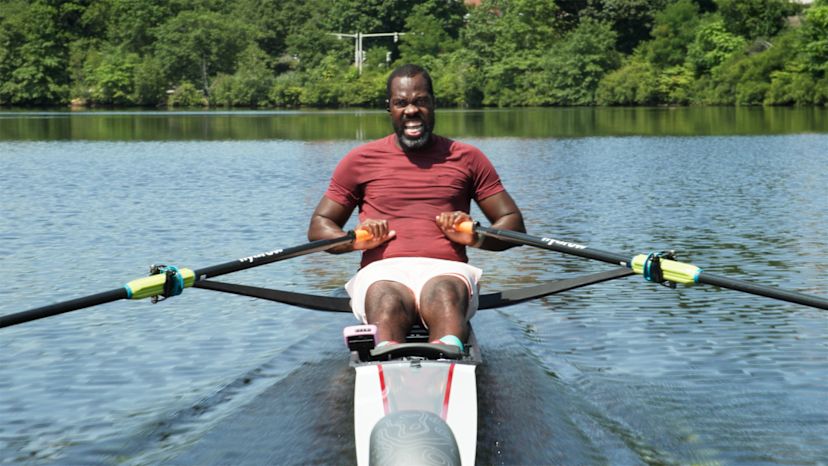Low-Impact Workouts: How to get a great, impact-free workout

Can low-impact workouts comprise your entire exercise regimen? Absolutely. When done correctly, low impact exercise at varying intensities will give you everything you need to succeed.
That being said, there are a few things you’ll want to look for in a low-impact workout to give you the best bang for your buck. In this article we’ll go through why you should consider a low impact workout, the right low-impact workout for your goals, and how to ensure you’re getting the most out of your low impact exercise regimen.
Why care about low-impact workouts?
Regardless of your level of fitness, low-impact workouts can truly be the bread and butter of your exercise routine. Here are just a few of the advantages that come with low-impact workouts.
Low-impact workouts reduce recovery time
Low-impact activity ensures you don’t need to spend as much time resting your joints. High-impact exercises on the other hand, such as running or contact sports, can lead to injuries or stress fractures if adequate rest time isn’t incorporated.
If you want to just be able to hop on a machine and exercise whenever you feel like it and not worry about scheduling out specific rest days, it may make more sense for low-impact workouts to be your primary form of exercise.
Low-impact workouts are beginner friendly
Haven’t moved around in a long time? Starting an exercise program for the first time in years… or ever? As you acclimate to regular exercise, the last thing you want to have happen is twist or contort the wrong way during a high-impact activity. Low-impact workouts can be as challenging as you want, but your risk of injury will be much lower, particularly as your body acclimates to getting in shape.
Low-impact workouts encourage good joint health
Joint pain is no laughing matter, and you want to avoid or reduce flare-ups as much as possible. You also want to improve your fitness – otherwise you probably wouldn’t be reading this article. Low-impact options help you get stronger, challenge yourself, and feel accomplished with your progress without having to risk joint injuries or pains that can linger for months or even years.
Low-impact workouts: When to consider them
We might be biased, but low-impact workouts are pretty rad. They can be your main form of exercise, and in some cases they actually should be your main form of exercise. Here are some special circumstances that may apply to you in which you’d especially want to find a low-impact solution.
Arthritis or past joint or bone injuries
Have you had a past injury that specifically involved joints, bones, or your spine? If the answer is yes, you’ll want to be extra cautious about how you move your body. Adopting a low-impact workout routine will likely result in less pain and discomfort in the long run.
Pregnancy
If you are pregnant or recently post-partum, consult with your doctor on what movements you can and cannot do. If you’re someone who loves a rigorous workout routine, finding a low-impact alternative can be a great way to scratch that itch and still get a sweaty workout while also respecting your body’s needs.
Cross-training supplementation
If your favorite form of exercise is a high-impact workout, great! Keep doing what you love. You’ll want to have a cross-training option in the picture to help you reduce chances of injury. A low impact workout gives you intensity and variety while also protecting your joints.
So… what are some low-impact workout options?
There are quite a few options that live under the umbrella of low-impact exercise. Whether you’re wanting to tone up, slim down, get strong, or just have an easier time getting out of bed in the morning or playing with the kids, there’s an option for you.
Rowing
You probably saw this one coming! Rowing is a terrific low-impact workout option because it engages the majority of muscle groups within your body, it’s easy to learn, and you can scale it up or down to meet your unique fitness level. Great grandparents and pro athletes alike use the same indoor rowing machine to get results.
Some rowers prefer interval training, such as Hydrow’s drive workouts, while others prefer a more steady workout that allows them to zone out, like Hydrow’s Journeys series that lets you row around the world from the comfort of your own home.
Resistance training or weight training
Exercising with free weights or resistance bands is one of the best, most controlled ways to build muscle tone and strength. When using weights or resistance in a controlled way, it’s easier to challenge yourself to work certain muscle groups to failure without risking injury or overdoing it. When your resistance workout is thorough, your muscles grow back stronger and thicker each time, which results in better tone and greater efficiency.
Hydrow’s On The Mat workouts include a collection of strength programming workouts you can do from home. Use our resistance band kit to spice things up even more.
Yoga or Pilates
No weights? No problem. Bodyweight workouts are popular and obviously portable, and when you know how to kick up your heart rate using your own body, it becomes easy and convenient to stay in shape when you’re on the go.
Mat-based workouts such as yoga and Pilates can be a great way to cross-train from your cardio efforts. Hydrow’s On The Mat series includes a library of guided yoga and Pilates workouts designed specifically to complement your week-to-week efforts on the rowing machine and give you a well-rounded fitness experience.
What to feel for during Hydrow workouts to get the best results
Okay, so you’re sold on the idea that low-impact workouts are pretty awesome… woohoo! Now what should you do to ensure you’re getting the most out of your workout?
Since the work you’re doing is not as explosive or high-impact, it’s important to pay attention to which muscle groups you engage during your workout. In physical therapy, proprioception refers to your body’s awareness of itself in space; it measures how well your brain can identify and engage certain muscles to move in certain ways.
The concept is simple: when you do a movement like a bicep curl, you want to identify the feeling in your bicep muscle and contract those muscle fibres to move the weight, rather than contorting your whole body to try and eke out five more reps.
If you’re previously exercised through resistance training, you’re probably familiar with this idea. But for many of us, “engage your muscles” is a phrase we’ve heard in phys ed or fitness classes all our lives, yet may not actually be doing when we’re working out. Engaging the correct muscles during certain movements can be a game changer for increasing muscle endurance and tone.
For rowing in particular, there are different muscle groups you’ll want to activate for different parts of the stroke.
- During the catch, you’ll engage your abdominal muscles, your lower back, and also your deltoids and triceps because you are pushing a bit to straighten your arms.
- During the drive you’ll engage your legs and glutes extensively, as this movement powers the actual rowing stroke and your split.
- During the finish, you’ll engage your back muscles and biceps. Your core and quadriceps will also continue to engage to help you hold your position.
- During the recovery, you’ll engage your trapezius muscles and also feel for stretch and lengthening in your hamstrings as you prepare for the next stroke.
For a complete rundown of the different parts of the rowing stroke and how to improve your rowing, go here.
---
Whether you’re looking to have a low impact workout be the centerpiece of your workout routine, or just want a fun cross-training option that keeps you engaged and motivated, Hydrow and indoor rowing can be the low impact solution that gets the job done. Sprinkle this healthy form of exercise into your work and you’ll notice improvements in energy and strength while also avoiding pain or long periods of downtime.


